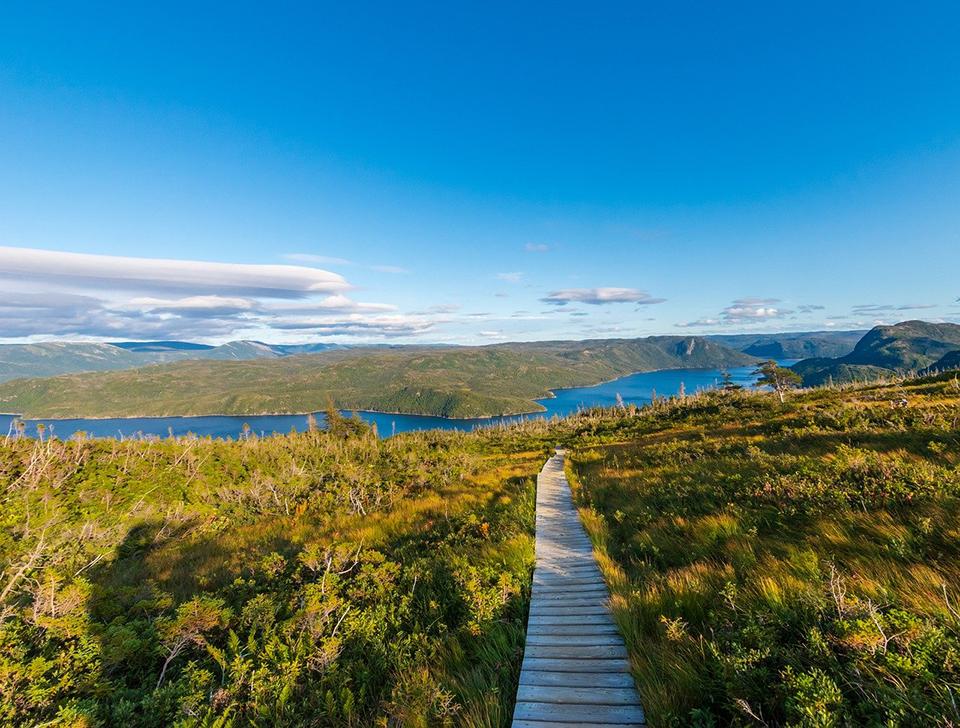
The view from the bridge at Saskatchewan River Crossing, Banff National Park / Rebecca Latson
On December 30th, 2020, the Traveler announced its expansion of national parks coverage to include those parks in Canada: 47 national parks, five national marine conservation areas, one national urban park, and 171 national historic sites.
I thought I’d wave a welcome to our northern neighbor by making this quiz #25 all about Canada’s parks. See how much you know before looking at the answers. You might learn something new, like I did while writing this piece.
1. True or False: The first national park service in the world was created by Canada.
a) True
b) False

A mountain and water vista, Waterton Lakes National Park / National Park Service
2. This warming wind blows over Waterton Lakes National Park more often than in most other places in Alberta. The name for this wind in the Blackfoot language means “snow-eater”:
a) Snag
b) Kelowna
c) Santa Anna
d) Chinook

Watch out for that polar bear! USFWS-Terry Debruyne
3. Which national park in Manitoba is famous for its polar bears?
a) Kluane
b) Aulavik
c) Terra Nova
d) Wapusk

Lake Ohara, Yoho National Park / Porco Rosso
4. True or False: Yoho National Park is located in Alberta Province.
a) True
b) False
5. In which national park is the tallest mountain in Canada – Mount Logan – located?
a) Vuntut
b) Ivvavik
c) Nahanni
d) Kluane
6. At which national park can you see the highest tides in the world?
a) Fundy
b) Gwaii Haanas
7. Which Canadian national park means “the top of the world” in the Inukitut language?
a) Quttinirpaaq
c) Ukkusiksalik
d) Auyuittuq
8. This national park, formerly known as St. Lawrence Islands National Park, is now called ____.
a) Thousand Islands
c) Sirmilik
d) Bruce Peninsula
9. Like many other parks battling invasive species, Canada’s smallest national park, Georgian Bay Islands National Park, is battling an invasive reed along the park’s shorelines that has been called the country’s worst invasive plant. This invasive reed is called ____.
a) Arundo
b) Phragmites
c) Neyraudia
d) Phalaris
10. What is the largest national park in Canada?
a) Jasper
b) Banff
c) Kootenay
Trivia

A boardwalk into the landscape, Gros Morne National Park / Pixabay-Felix Dilly
Gros Morne National Park, located on Newfoundland Island, has the unique distinction of being one of two sites on earth where you can walk on exposed mantle rocks, forced up to the earth’s surface about 500 million years ago. These mantle rocks are composed of a coarse-grained, dark-colored rock called peridotite, which has been weathered to an orange color due to oxidation (rusting) of the rock’s iron content. The Gros Morne landscape is a UNESCO World Heritage Site. To learn more about the earth’s mantle, click here.
Let’s remain on the topic of geology a little longer and take a visit to Canada’s smallest national park: Georgian Bay Islands National Park, accessible only by boat. Comprised of 63 islands and islets, this national park is the location of the world’s largest fresh-water archipelago and is a part of the Canadian Shield. The Canadian Shield, an exposed portion of Precambrian rock approx. 4.3 billion years old, covers over 3 million square miles (8 million square kilometers) of eastern, central, and northwestern Canada, with fingers reaching into northern Minnesota, Wisconsin, Michigan, and New York, in the United States.
Grasslands National Park, located in Saskatchewan Province, “has thousands of archaeological find sites, artifacts, and is one of the largest concentrations of undisturbed precontact cultural resources in Canada ... Indigenous habitation dates back to 10,000 years ago. By the 1600's, the Gros Ventre followed the bison herds in this area. More recently, the Assiniboine, Cree, Sioux, and Blackfoot also inhabited this grassland area on a seasonal basis. Campsites, tipi rings, vision quest sites, medicine wheels, and bison drive lanes are some of the cultural heritage.”
Quiz Answers
1a True
Canada was the first country in the world to create a national park service. In 1911, The Dominion Parks Branch was created, now known as Parks Canada. The U.S. National Park Service was created five years later, in 1916.
2d
“Chinook (‘snow-eater’) winds have been known to raise temperatures from minus 2 degrees F (-19 degrees C) to 72 degrees F (22 degrees C) in just one hour.” To learn more about Chinook winds, click here.
3d
“Wapusk is located in Northern Manitoba near Churchill. Its name comes from the Cree word for ‘polar bears.’”
4b False
Yoho National Park is located in the province of British Columbia.
5d
Kluane National Park and Reserve is home to 19,551-foot (5,959-meter) tall Mount Logan.
6a
“At Fundy National Park, the difference between high and low tide can be as much as 39 feet (12 meters). At the head of the bay, the tide can rise 52.5 feet (16 meters), the height of a four-story building.”
7a
“The northern-most national park in Canada is Quttinirpaaq National Park. Quttinirpaaq means ‘the top of the world’ in Inuktitut.”
8a
Originally established in 1904 as St. Lawrence Islands National Park, the name was changed in 2013 to Thousand Islands National Park.
9b
Phragmites is considered the country’s worst invasive plant, and you can learn more about it in this Traveler article.
10d
Wood Buffalo National Park, encompassing almost 28,000 square miles (~45,000 square kilometers), is Canada’s largest National Park as well as being one of the largest national parks in the world. Not only that, but this park is also home to the world’s largest beaver dam.
References
Because I don’t know much about Canadian parks, myself, I used information found on the Parks Canada website as well as the following references, from which I took a few quiz questions to use for this quiz:
https://www.nationalgeographic.com/travel/article/canada-parks-quiz-part-1
https://www.pc.gc.ca/en/pn-np/ab/waterton/nature/environment/climat-climate/chinooks
https://www.funtrivia.com/playquiz/quiz3086472355b50.html
https://www.softschools.com/quizzes/geography/canada_national_parks/quiz1110.html
https://www.outdoorproject.com/canada/newfoundland-and-labrador/tablelands
https://www.westjetmagazine.com/story/article/canada-national-parks-facts









Add comment